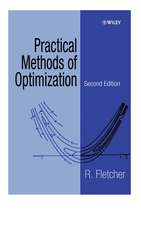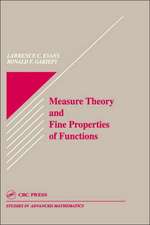Solutions Manual for Lang’s Linear Algebra
Autor Rami Shakarchien Limba Engleză Paperback – 9 aug 1996
Preț: 630.06 lei
Preț vechi: 741.25 lei
-15% Nou
Puncte Express: 945
Preț estimativ în valută:
120.56€ • 126.13$ • 100.15£
120.56€ • 126.13$ • 100.15£
Carte tipărită la comandă
Livrare economică 02-16 aprilie
Preluare comenzi: 021 569.72.76
Specificații
ISBN-13: 9780387947600
ISBN-10: 0387947604
Pagini: 200
Ilustrații: XI, 200 p.
Dimensiuni: 155 x 235 x 11 mm
Greutate: 0.29 kg
Ediția:1996
Editura: Springer
Colecția Springer
Locul publicării:New York, NY, United States
ISBN-10: 0387947604
Pagini: 200
Ilustrații: XI, 200 p.
Dimensiuni: 155 x 235 x 11 mm
Greutate: 0.29 kg
Ediția:1996
Editura: Springer
Colecția Springer
Locul publicării:New York, NY, United States
Public țintă
Professional/practitionerCuprins
I Vector Spaces.- §1. Definitions.- §2. Bases.- §4. Sums and Direct Sums.- II Matrices.- § 1. The Space of Matrices.- §2. Linear Equations.- §3. Multiplication of Matrices.- III Linear Mappings.- § 1. Mappings.- §2. Linear Mappings.- §3. The Kernel and Image of a Linear Map.- §4. Composition and Inverse of Linear Mappings.- §5. Geometric Applications.- IV Linear Maps and Matrices.- § 1. The Linear Map Associated with a Matrix.- §2. The Matrix Associated with a Linear Map.- §3. Bases, Matrices and Linear Map.- V Scalar Products and Orthogonality.- § 1. Scalar Products.- §2. Orthogonal bases, Positive Definite Case.- §3. Application to Linear Equations; the Rank.- §4. Bilinear Map and Matrices.- §5. General Orthogonal Bases.- §6. The Dual Space and Scalar Products.- §7. Quadratic Forms.- §8. Sylvester’s Theorem.- VI Determinants.- §2. Existence of Determinants.- §3. Additional Properties of Determinants.- §4. Cramer’s rule.- §5. Triangulation of a Matrix by Column Operations.- §6. Permutations.- §7. Expansion Formula and Uniqueness of Determinants.- §8. Inverse of a Matrix.- §9. The Rank of Matrix and Subdeterminants.- VII Symmetric, Hermitian and Unitary Operators.- §1. Symmetric Operators.- §2. Hermitian Operators.- §3. Unitary Operators.- VIII Eigenvectors and Eigenvalues.- §1. Eigenvectors and Eigenvalues.- §2. The Characteristic Polynomial.- §3. Eigenvalues and Eigenvectors of Symmetric Matrices.- §4. Diagonalization of a Symmetric Linear Map.- §5. The Hermitian Case.- IX Polynomials and Matrices.- §2. Polynomials of Matrices and Linear Maps.- X Triangulation of Matrices and Linear Maps.- §1. Existence of Triangulation.- §3. Diagonalization of Unitary Maps.- XI Polynomials and Primary Decomposition.- §1. The EuclideanAlgorithm.- §2. Greatest Common Divisor.- §3. Unique Factorization.- §4. Application to the Decomposition of a Vector Space.- §5. Schur’s Lemma.- §6. The Jordan Normal Form.- XII Convex Sets.- §4. The Krein-Milman Theorem.- APPENDIX Complex Numbers.
















